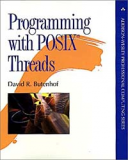Книга: Programming with POSIX® Threads
1.1 The "bailing programmers"
1.1 The "bailing programmers"
This was charming, no doubt: but they shortly found out
That the Captain they trusted so well
Had only one notion for crossing the ocean,
And that was to tingle his bell.
Three programmers sail out to sea one fine day in a small boat, They sail quite some distance from shore, enjoying the sun and sea breeze, allowing the wind to carry them. The sky darkens, and a storm strikes. The small boat is tossed violently about, and when the storm abates the programmers are missing their boat's sail and most of the mast. The boat has sprung a small leak,and there is no land in sight.
The boat is equipped with food, water, oars, and a bailing bucket, and the programmers set to work. One programmer rows, and monitors the accumulating water in the bottom of the boat. The other programmers alternately sleep, watch the water level,or scan the horizon for sight of land or another ship.
An idle programmer may notice rising water in the boat, and begin bailing. When both idle programmers are awake, and become simultaneously concerned regarding their increasing dampness, they may both lunge for the bailing bucket—but one will inevitably reach it first, and the other will have to wait.
If the rower decides that bailing is required while both his companions sleep,a nudge is usually sufficient to awaken a programmer,allowing the other to continue sleeping. But if the rower is in a bad mood, he may resort to a loud yell,awakening both sleeping programmers. While one programmer assumes the necessary duty, the other can try to fall asleep again.
When the rower tires, he can signal one of the other programmers to take over the task, and immediately fall into a deep sleep waiting to be signaled in turn. In this way, they journey on for some time.
So, just what do the Bailing Programmers have to do with threads? I'm glad you asked! The elements of the story represent analogies that apply to the Pthreads programming model. We'll explore some additional analogies in later sections, and even expand the story a little, but for now consider a few basics:
A programmer is an entity that is capable of independent activity. Our programmers represent threads. A thread is not really much like a programmer, who, as we all know, is a fascinatingly sophisticated mixture of engineer, mathematician, and artist that no computer can match. Still, as a representation of the "active element" in our programming model, it will be sufficient.
The bailing bucket and the oars are "tokens" that can be held by only one individual at a time. They can be thought of as shared data, or as synchronization objects. The primary Pthreads synchronization object, by the way, is called a mutex.
Nudges and shouts are communication mechanisms associated with a synchronization object, on which individuals wait for some condition. Pthreads provides condition variables, which may be signaled or broadcast to indicate changes in shared data state.
- Восстановление "безнадежных" баз данных. InterBase Surgeon
- Основные "рычаги" управления производительностью
- 4.4.4 The Dispatcher
- About the author
- Chapter 7. The state machine
- Appendix E. Other resources and links
- Example NAT machine in theory
- Using Double Quotes to Resolve Variables in Strings with Embedded Spaces
- The final stage of our NAT machine
- Compiling the user-land applications
- The conntrack entries
- Untracked connections and the raw table




